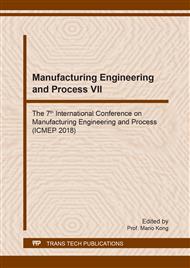p.1
p.15
p.23
p.28
p.39
p.48
p.54
p.63
p.72
Forming Mechanism and Bonding Properties of Fe-Si-B Amorphous Strip/Al Foil Laminate Composites by Ultrasonic Addictive Manufacturing (UAM)
Abstract:
Iron-based amorphous foils and metallic aluminum foils are stacked in alternating layer and welding as laminate composites by ultrasound consolidation process with high-frequency acoustic vibrations. It makes the material to play their own advantages as the new focus. In the consolidation process, the most important standard parameters of the mechanical properties of the material are mainly controlled by the normal force, amplitude of the ultrasonic vibration and the travel speed of the sonotrode imposed by the forming. Ultrasonic vibrations, typically 20 kHz, are applied to the foil laterally (along its width) through a sonotrode (welding tool) .In this paper, the optimum parameters of 25μm amplitude, 2.5kN static force and 20mm / s traveling speed are obtained. It is well-known that the microstructure is the most intuitive way to measure the mechanical properties of materials, including hardness and so on. In addition, in this paper, the forming mechanism of Al 1080/ amorphous (Fe-Si-B) and the connection performance of ultrasonic bonding technology are described in detail. scanning electron microscopy (SEM) found that there is a mechanical interface mechanism and metallurgical bonding mechanism. And the recrystallization temperature of aluminum was calculated. The kinetics of interfacial growth at the grain boundary was analyzed. The composition of interfacial material was analyzed by energy dispersive spectroscopy (EDS) in the metallurgical bonding interface of the recrystallized region. It was preliminarily concluded that the Al-rich FeAl3 phase and the AlB2 phase were inferred. In the exfoliation experiment, it was found by X-ray diffractometry (XRD) that the amorphous did not appear to be crystallized. Finally, the laminated materials were tested for mechanical properties.
Info:
Periodical:
Pages:
39-47
Citation:
Online since:
July 2018
Authors:
Price:
Сopyright:
© 2018 Trans Tech Publications Ltd. All Rights Reserved
Share:
Citation:


